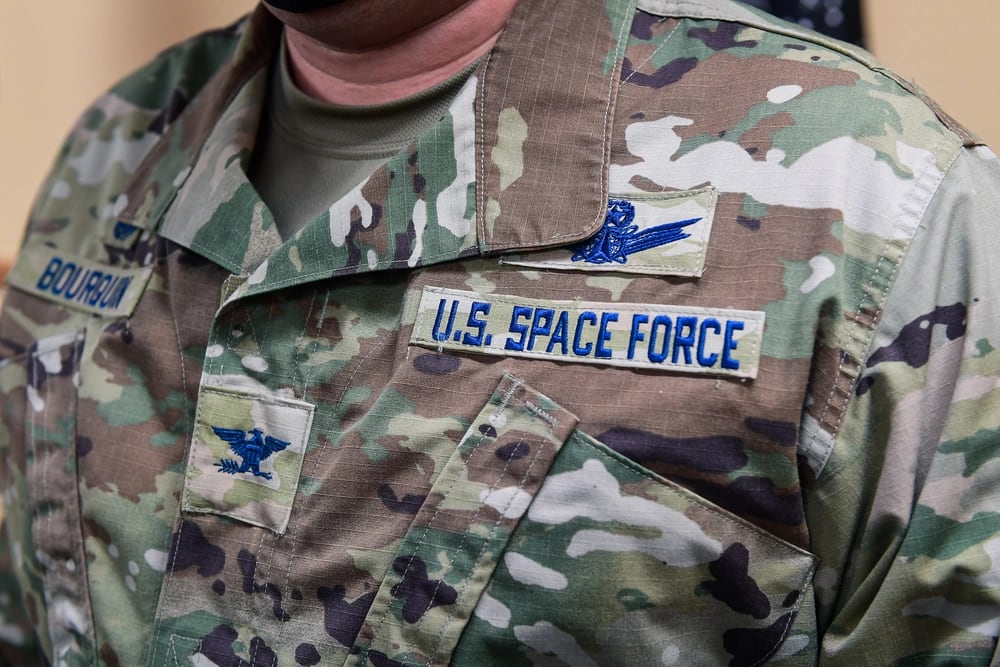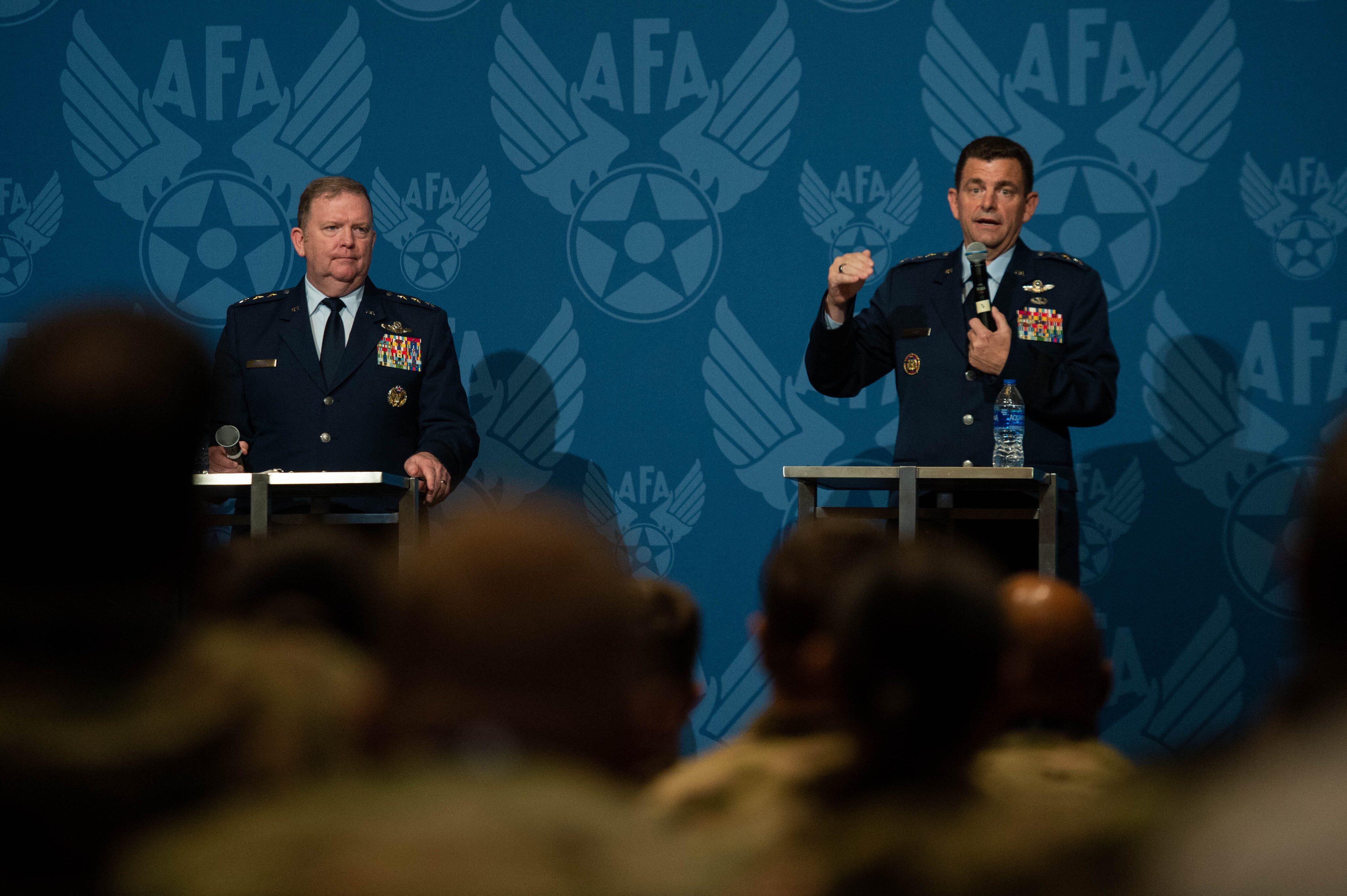The Space Force on Thursday announced a cohort of nearly 700 soldiers, sailors and Marines who will join the fledgling service in the next year, marking its largest batch of transfers from outside the Department of the Air Force so far.
But those 670 troops — plus 259 additional civilian employees — face an immediate roadblock to becoming guardians: they can’t change jobs until Congress passes, and President Joe Biden signs, a fiscal 2022 defense spending bill.
The federal government will stay open until Dec. 3 under a stopgap funding measure Congress passed Sept. 30. But the legislation doesn’t allow the Space Force to take on new personnel or missions, like Army communications payloads that ride on satellites flown by guardians. The Space Force has never received on-time annual funding since its creation in December 2019, slowing the new service’s efforts to grow.
“All those systems on orbit, plus the ground stations that operate those capabilities and integrate those capabilities, that all transfers over to the Space Force beginning 1 October if there isn’t a continuing resolution,” Chief of Space Operations Gen. John “Jay” Raymond said during a Defense One event on Monday. “If there’s a continuing resolution, we’ll have to wait until that is resolved.”
When troops can transfer in depends on their path to entering the service, Space Force spokesperson Lynn Kirby said on Friday. Soldiers, sailors and Marines who were announced as the first interservice transfers in June can still formally join, because their jobs were funded by the fiscal 2021 budget. Troops who volunteered to join and were announced on Sept. 30 could also see a delay, depending on how long the government is open under a continuing resolution, but will need time for their paperwork to process and may not have much of a problem. Those who are coming in as part of Army and Navy units that the Space Force is absorbing will not be allowed to transfer until 2022 defense legislation is enacted.
The Army will send the most uniformed transferees to the Space Force at 603 soldiers, followed by 49 sailors and 18 Marines. They’ll jump into jobs like cyber defense, satellite operations, intelligence analysis and acquisition. Service officials outlined the jobs they anticipate will be available during a Jan. 28 online town hall.
About 450 of the troops chosen had previously applied in a pool of more than 3,700 active-duty officers and enlisted volunteers. The Space Force picked 50 of them for its first cohort of transfers that started arriving in July, after more than 2,400 airmen who were already assigned to the Space Force — largely as satellite operators — began formally moving over in September 2020.
Another 215 uniformed members, plus the approximately 260 civilians, will come over as part of 15 satellite communications units that are transferring from the Army and Navy.
The Army plans to send over about 500 jobs and $78 million worth of operations, maintenance and personnel resources, including five wideband SATCOM operations centers and four regional SATCOM support centers that allow troops to send data in combat. The Navy’s narrowband satellite enterprise will transfer 13 satellites and 76 jobs to the Space Force as well. Other units will follow in later years.
“To officially transfer from one military service to another, a military member separates from the current service and commissions or enlists into the new service in their current rank,” the Space Force said last year.
“On the official date of transfer, enlisted members will be administered the oath of enlistment and sign enlistment contracts into the Space Force. Officers will be administered the oath of office and sign official Space Force commissioning documents.”
Officers and enlisted must spend up to four years on active duty once they join the Space Force, depending on their previous career. Service officials have said troops who transfer in will keep their same grade.
Together, this round of 929 personnel comprises about 7 percent of the newest military branch, which is on track to have more than 13,600 employees once the latest batch arrives. It plans to grow to around 16,000 members overall.
Matt Jobe, a senior policy analyst in the service’s personnel branch, said in January that they hope to have a firm plan in 2023 to open the Space Force to anyone who wants to join — not just those with prior space experience. The Space Force is not currently accepting more transfer applications.
“Successfully integrating the units, capabilities and people from sister services into the Space Force is critical to our mission and was one of the driving forces in creating the new service,” Vice Chief of Space Operations Gen. David Thompson said in a release Thursday. “We look forward to welcoming these soldiers, sailors, Marines and civilians into our force and encourage them to apply their experiences and perspectives to help us meet the needs of the joint force and shape a unique service culture.”
RELATED

Nearly 2,000 people from across the military and the American public are expected to join the Space Force next year, growing from 6,434 active-duty troops to 8,400. Its civilian corps is also slated to grow from 3,545 to 4,364 employees, according to the service’s fiscal 2022 budget request.
To prepare soldiers, sailors and Marines to become guardians, the service is launching a welcome course at Peterson Space Force Base, Colorado, in mid-October.
The “Guardian Orientation Course” will run 12 times a year at Peterson’s National Security Space Institute, and as many as three times a year in other locations as needed, Space Force spokesman Mike Pierson said on Wednesday. The first class will take place Oct. 18-22.
“Each unclassified Guardian Orientation Course provides 50 students with 29 hours of instructor contact over 40 hours in one week. Students will hear from senior leader mentors, take tours of Space Force facilities and receive briefings and lectures on a wide variety of topics including Space Force culture, organization, promotion systems and history,” Pierson said in an email. “NSSI expects to offer this course to all current and future transferees within a year of their transfer.”
RELATED

Crafting an introduction for newcomers with significant prior military experience is a challenge that no service has had to think through since the Air Force became a separate branch of the military in 1947.
“We knew that when the Army, Navy, Marine counterparts started coming over, we had to do something more,” Air National Guard Brig. Gen. Shawn Bratton, who runs the Space Training and Readiness Command, told reporters at the Air Force Association’s annual Air, Space and Cyber Conference at National Harbor, Maryland, on Sept. 22. “We don’t want it to be a ‘figure it out for yourself’ kind of environment.”
Once an incoming guardian completes that welcome course, the Space Force expects to send them to classes tailored for the amount of space knowledge they need in their new job.
“An Army FA40, who is a space operator, has a high level of space experience — years of experience. They probably need less training, if any, and will come right over to the Space Force in what, today, we would call the space operator skill,” Bratton said.
If an infantry officer was coming over, he continued, they wouldn’t retake officer training courses. But they could head into the classroom to learn the basics of satellite maneuvers or watching for orbital threats.
“We’ve made a couple tailored options specifically for the inter-service transfers that are kind of a small, medium, large, if you will, of how much training they need,” Bratton said. “We’ve done that specifically for the space operators.”
The education and training enterprise is one piece of a broader effort to establish a unique culture within the Space Force as it brings together people from across the Pentagon. It hopes to offer more personalized and flexible careers for guardians than is typical in the other armed services, and to adopt certain best practices from the private sector.
That entails letting troops vie for future jobs in a “talent marketplace” that resembles the civilian hiring process, and the ability to toggle between full- and part-time work in military and industry, according to the Space Force’s new human capital plan published Sept. 21.
“Instead of saying, ‘I’m looking for a major that has 10 years of orbital warfare experience and maybe four years of electronic warfare experience as a prior enlisted’ … that person may be qualified for the position, but may not be the best guardian available for where we need them to go,” Brig. Gen. Shawn Campbell, the Space Force’s deputy human capital officer, told reporters last week.
The service won’t move a guardian simply because it’s time for them to leave a job or pick up another skill set to climb the ladder. It wants to place a higher premium on where people want to live for family or professional purposes, as well as the kind of career path they’d like to pursue.
“I’m looking at the position to recognize what level of mastery I need, and then I can go into the talent marketplace and I can pull out all of the guardians that have those requisite competencies at that level, and then make decisions about who to place into that position,” Campbell added. “We don’t want to have a pyramid. That’s not, we think, the best way for us to neither develop nor employ our guardians.”
Editor’s note: This story was updated at 5:20 p.m. on Oct. 1 to include new information from the Space Force.
Rachel Cohen is the editor of Air Force Times. She joined the publication as its senior reporter in March 2021. Her work has appeared in the Washington Post, the Frederick News-Post (Md.), Air and Space Forces Magazine, Inside Defense, Inside Health Policy and elsewhere.





